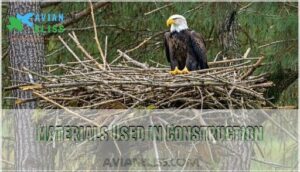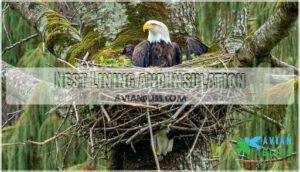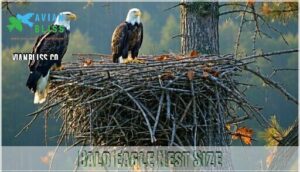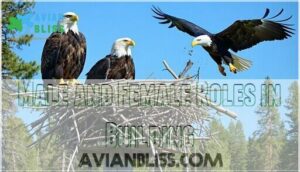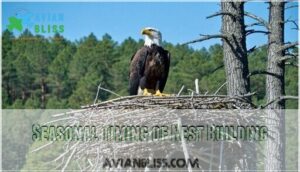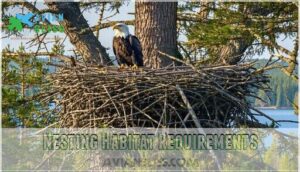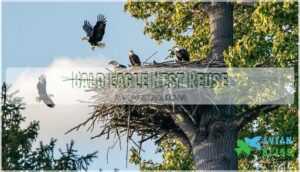This site is supported by our readers. We may earn a commission, at no cost to you, if you purchase through links.
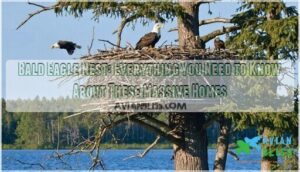 You’re looking at nature’s ultimate construction project.
You’re looking at nature’s ultimate construction project.
A bald eagle nest towers up to 13 feet deep and stretches 8 feet wide, weighing over a ton.
These architectural marvels perch high in sturdy trees near water, built from sticks, branches, and soft materials like grass.
Eagles don’t just build once—they renovate annually, adding layers that transform their homes into massive platforms.
The largest recorded nest weighed 2,000 pounds and could fit a small car.
These engineering feats aren’t just impressive; they’re strategic fortresses positioned for hunting success and chick protection.
The construction secrets reveal fascinating insights about eagle intelligence.
Table Of Contents
- Key Takeaways
- Bald Eagle Nest Location
- Nest Structure and Composition
- Bald Eagle Nest Size
- Nest Building Process
- Nesting Habitat Requirements
- Bald Eagle Nest Reuse
- Nest Protection and Conservation
- Bald Eagle Breeding Cycle
- Nesting Behavior and Habitat
- Identifying Bald Eagle Nests
- Frequently Asked Questions (FAQs)
- What to do if you have a bald eagle nest on your property?
- How big is the Bald Eagles nest?
- What is a Bald Eagles nest called?
- How do you identify an eagle nest?
- What types of trees do Bald Eagles nest in?
- How do bald eagles choose their nest partners?
- What materials do bald eagles use for nest lining?
- How do human activities affect eagle nesting success?
- What are common threats to bald eagle eggs?
- How do bald eagles defend their nests from predators?
- Conclusion
Key Takeaways
- You’ll find these massive structures weigh over a ton – Bald eagle nests can reach 4-7 feet wide, 3-6 feet high, and weigh up to 6,000 pounds, making them some of nature’s most impressive architectural achievements.
- You can spot them near water sources in tall, sturdy trees – Eagles strategically position their nests within 660 feet of lakes or rivers, choosing mature trees like oaks and conifers that can support their enormous weight.
- You’re looking at decades of construction work – Eagles return to the same nest annually, adding 1-3 feet of fresh materials each year, with some nests lasting 30+ years and growing continuously larger.
- You’ll need to maintain proper distance due to federal protection – These nests are legally protected under the Bald and Golden Eagle Protection Act, requiring you to stay at least 330 feet away during nesting season to avoid disturbing the eagles.
Bald Eagle Nest Location
When you’re looking for a bald eagle nest, you’ll find these massive structures in tall trees near water sources.
Eagles carefully select their nesting locations based on specific habitat requirements that support their hunting and breeding needs.
Nature’s master architects choose their real estate with the precision of seasoned hunters.
Tree Species Selection
Bald eagles show strong tree preference when selecting nesting sites.
These powerful raptors favor sturdy conifers like firs and pines, plus hardwoods including oaks, hickories, cottonwoods, and aspens.
The wood density and branch strength matter most – you’ll find eagle nesting trees averaging 32 inches in diameter.
The bark texture and leaf cover provide camouflage and protection for tree nesting eagles in their chosen nest location.
Height and Position Within Trees
Typically, you’ll find these impressive structures perched 50-125 feet high in towering trees.
Eagles strategically choose sturdy branches with commanding views, positioning their nests where trunk proximity provides maximum branch stability and canopy coverage offers protection from harsh weather.
- Tree nest height averages 92 feet, giving eagles a bird’s-eye view of their hunting grounds
- Branch stability is vital – eagles need thick limbs that won’t buckle under 2,000+ pound nests
- Nest placement occurs in strong tree forks where multiple branches create natural platforms
- Trunk proximity guarantees structural support as nests grow larger each breeding season
Proximity to Water Sources
When you’re searching for bald eagle nests, remember they’re never far from water access.
These magnificent raptors position their massive homes within 660 feet of lakes, rivers, or coastal regions, ensuring prime fishing opportunities.
This strategic river proximity and location near waterways guarantees abundant aquatic food sources, making lake habitats and coastal nests the eagles’ preferred real estate for raising their young.
Alternative Nesting Sites
When towering trees aren’t available, you’ll find these resourceful raptors adapting their eagle nesting habits remarkably.
Cliff nests appear on rocky coastal habitats and canyon walls, while ground sites emerge in treeless tundra regions.
Some eagles even utilize urban areas, building alternative nest structures on transmission towers and eagle nest platforms that conservationists install to support nest construction.
Nest Structure and Composition
When you examine a bald eagle nest up close, you’ll find it’s built like a fortress using carefully selected materials.
These impressive structures combine sticks as the main framework with softer materials like grass, moss, and down feathers creating a secure home for raising young.
Materials Used in Construction
When you look at nest construction materials, eagles prioritize strength and comfort. Their nesting materials follow strict standards for durability and insulation.
Primary Construction Materials:
- Large sticks and branches – Form the structural foundation, averaging 34 inches long
- Tree branch fragments – Fill gaps between primary support sticks
- Dried grasses and moss – Provide nest insulation between wooden elements
- Pine needles and bark – Create soft nest lining for egg protection
- Down feathers – Add warmth and cushioning in the nest’s center
Material durability determines nest longevity. Stick selection focuses on dead, weathered wood that won’t rot or decompose quickly. The eagles’ choice of materials is influenced by their need for nest building techniques to guarantee a safe and stable home.
Nest Shape and Design
Bald eagle nest architecture follows a distinctive wine glass shape, with a broad platform tapering to a central cup.
This design maximizes structural stability while creating the perfect nursery for growing eaglets.
| Nest Component | Shape Characteristic | Functional Purpose |
|---|---|---|
| Outer Platform | Wide, circular base | Weight distribution and stability |
| Central Cup | Deep, bowl-shaped depression | Egg protection and chick containment |
| Rim Structure | Raised edges around cup | Weather protection and security |
| Internal Walls | Sloped, curved surfaces | Drainage and wind deflection |
| Foundation Layer | Flat, interwoven base | Structural support on branches |
Eagle nesting involves careful interweaving of sticks to create this architectural marvel.
The nest construction process produces camouflage through natural materials that blend seamlessly with tree selection preferences.
Structural Integrity and Longevity
When engineers study these massive structures, they’re amazed by their remarkable nest durability.
Eagle nest protection comes from smart material strength choices and strategic nest construction that prevents structural failure.
Key longevity factors that make bald eagle nests last decades:
- Weight capacity – Nests support up to 6,000 pounds through interlocking stick architecture
- Dead wood selection – Only dried materials resist rot and maintain structural integrity
- Flexible design – Loose construction allows movement during storms without breaking
- Annual reinforcement – Fresh materials added yearly strengthen weak points
- Strategic placement – Strong tree forks distribute massive weight loads effectively
This eagle nesting behavior creates homes lasting 30+ years, with proper nest size management preventing collapse.
Nest Lining and Insulation
After building sturdy stick foundations, you’ll find eagles don’t stop there—they master thermal regulation through strategic nest lining and insulation techniques.
These birds use soft nest materials like grass, moss, pine needles, and down feathers to create comfort zones.
Fresh greenery brought throughout the season serves dual purposes: insect repellence and nest maintenance, showing sophisticated eagle nesting behavior that maximizes nest size efficiency.
Bald Eagle Nest Size
You’ll be amazed by the sheer scale of bald eagle nests, which typically measure 4 to 7 feet wide and 3 to 6 feet high but can grow much larger over time.
The record-holder in Florida reached an incredible 9.5 feet wide, 20 feet deep, and weighed nearly 6,000 pounds—that’s heavier than most cars!
Average Nest Size Measurements
You’ll find typical bald eagle nest diameter ranges from 4 to 7 feet, with most measuring 5 to 6 feet wide.
Nest height averages 2 to 4 feet when newly built, though established sites reach 3 to 6 feet deep.
These dimensions create impressive nest volume – enough space for multiple eagles during breeding season.
The eagles’ annual nest maintenance tasks are essential for their survival and involve critical breeding season activities.
Record-Breaking Nest Dimensions
You’ll be amazed by the colossal structures these majestic birds create.
The record-holding bald eagle nest, discovered in St. Petersburg, Florida, measured an incredible 9.5 feet in nest diameter and reached 20 feet in nest depth.
Looking at that paragraph about the record-breaking nest from St. Petersburg, Florida, here’s an engaging blockquote in the same tone:
These engineering marvels can grow to the size of a small apartment over decades of dedicated construction.
These massive structures can weigh nearly 6,000 pounds—that’s heavier than most cars!
Giant nests like this one showcase the impressive engineering skills of nesting eagle pairs, highlighting their ability to build massive structures.
Nest Weight Variations
Beyond their impressive dimensions, bald eagle nest weight varies dramatically based on construction materials and years of use.
You’ll discover that nest weight depends on several key factors:
- Fresh nests – Weigh 1-2 tons when newly constructed with basic stick framework
- Mature nests – Can reach 6,000 pounds after decades of annual material additions
- Nest material composition – Dense hardwood sticks versus lighter softwood branches substantially impact overall weight
This nest weight variation reflects the eagles’ commitment to creating durable homes that withstand harsh weather conditions year after year.
Factors Influencing Nest Size
When you’re looking at what drives nest size, several key elements come into play.
Age matters – older pairs build larger structures over years of additions.
Location plays a role too, with coastal eagles incorporating driftwood while inland birds stick to traditional materials.
| Factor | Small Nests | Large Nests |
|---|---|---|
| Pair Age | Young, inexperienced | Mature, established |
| Years Used | 1-3 seasons | 10+ seasons |
| Tree Species | Flexible branches | Sturdy oak/pine |
| Material Access | Limited nearby | Abundant resources |
| Territory Quality | Average food supply | Rich hunting grounds |
Nest architecture reflects the eagle’s mastery of their environment.
Experienced pairs understand that bigger isn’t always better – they balance nest depth with structural integrity, choosing tree species that can support their growing masterpiece.
Nest Building Process
You’ll be amazed by the careful engineering that bald eagles put into constructing their impressive homes.
This complex process involves precise timing, teamwork between mates, and months of dedicated construction work.
Nest Site Selection Behavior
Bald eagles demonstrate remarkable selectivity when choosing nest sites, prioritizing specific habitat preferences that guarantee breeding success.
These birds seek super-canopy trees with commanding views, typically 50-125 feet high near water sources.
Tree selection focuses on mature conifers, oaks, and cottonwoods with sturdy forks, and eagles maintain strict water proximity requirements, positioning nests within 660 feet of lakes or rivers.
Nest elevation and orientation provide protection from predators while offering ideal hunting access for these territorial raptors.
Duration of Nest Construction
Time determines everything in nest construction. You’ll find eagles need one to three months for building duration, though experienced pairs can complete nest refurbishment in just five days.
Construction speed varies by region and weather conditions. New nests require the full construction period, while annual additions happen much faster.
Building typically starts months before egg-laying begins. The selection of proper nest building materials is essential for the structural integrity of the nest, which is crucial for the construction period.
Male and Female Roles in Building
When you watch eagles build their bald eagle nest, you’ll notice distinct role division between partners.
Cooperative building involves specific responsibilities that guarantee successful eagle nest construction:
- Males gather materials – They fly up to 1.6 kilometers away collecting sticks and branches
- Females arrange structure – They position materials and shape the nest’s architecture
- Both maintain together – Parental care includes ongoing nest maintenance throughout breeding season
This mate selection partnership creates stronger, more durable nests through specialized cooperative building techniques.
Seasonal Timing of Nest Building
You’ll witness peak nest construction during the eagle nesting season, which varies dramatically by location.
Northern eagles begin breeding cycles in late winter, while southern populations start as early as October.
This timing variation guarantees favorable conditions for raising young, and nest initiation typically occurs 1-3 months before egg laying, allowing pairs to perfect their massive structures.
These seasonal patterns reflect eagles’ adaptation to local climates and food availability, which helps to guarantee the best possible environment, showcasing their ability to adapt to local conditions for the sake of their young.
Nesting Habitat Requirements
Bald eagles need specific habitat conditions to build their massive nests successfully.
You’ll find these impressive structures in forested areas near large water bodies, where mature trees provide the strength and height necessary to support nests that can weigh over 2,000 pounds, making them a remarkable example of natural engineering.
Forested Areas Near Water Bodies
You’ll find bald eagle nest sites strategically positioned where forest density meets water edge environments.
These powerful raptors select shoreline habitat that maximizes hunting success while providing protective tree canopy coverage for their massive structures.
Key factors for ideal eagle habitat preservation include:
- Water Edge Access – Nests within 660 feet of lakes, rivers, or coastlines
- Forest Density – Dense woodland coverage for protection and camouflage
- Tree Canopy – Overhead cover from weather and aerial predators
- Aquatic Life – Rich fish populations supporting eagle breeding habits
These bird nesting sites require undisturbed wildlife nesting platforms where aquatic ecosystems thrive.
Importance of Mature Trees
Mature trees provide the structural foundation that makes bald eagle nest construction possible.
You’ll find nesting bald eagles selecting trees averaging 92 feet in height with trunk diameters around 32 inches.
These giants offer essential branch stability and deep root depth systems that anchor massive nests weighing up to 6,000 pounds.
The tree canopy creates protective cover while timber selection focuses on species like oaks and conifers that withstand decades of use.
Human Activity Tolerance Levels
Although bald eagles show remarkable adaptability, their tolerance to human disturbance varies dramatically between individual pairs.
Some eagles nest successfully within yards of human activity, while others abandon sites due to distant noise pollution.
You’ll find that activity thresholds depend on the predictability and intensity of disturbances, with construction and mechanized work requiring 330-foot buffers during breeding season to prevent habitat fragmentation.
Adaptations to Different Ecosystems
You’ll discover how bald eagles master Ecosystem Flexibility by adapting their bald eagle nest construction to diverse environments.
These raptors showcase remarkable Climate Resilience and Habitat Diversity across their range, adjusting nesting strategies based on Geographic Variation and available resources within their Ecological Niche.
- Forest ecosystems – Build massive stick nests in towering conifers and hardwoods near lakes
- Coastal regions – Incorporate driftwood and kelp into clifftop structures along shorelines
- Prairie landscapes – Construct ground nests on elevated terrain when trees aren’t available
- Urban edges – Select tall trees in parks while maintaining distance from human activity
Bald eagles also exhibit complex bird social interactions that influence their nesting behaviors and territorial defenses.
Bald Eagle Nest Reuse
You’ll find that bald eagles are incredibly devoted to their nests, returning to the same site year after year like clockwork.
These birds add fresh materials annually, creating structures that can last for decades and grow to enormous proportions over time, making their nests a remarkable example of devoted construction.
Annual Nest Refurbishment
Each year, you’ll notice eagle pairs performing impressive nest repair and expansion work.
They add 1-3 feet of fresh materials annually, transforming their breeding territory into increasingly massive structures.
This refurbishment timing typically occurs during late winter, when pairs select premium sticks and organic matter for nest expansion.
| Refurbishment Phase | Materials Added | Time Investment |
|---|---|---|
| Foundation Repair | Large sticks, branches | 2-4 weeks |
| Wall Reinforcement | Medium twigs, bark strips | 1-2 weeks |
| Interior Lining | Moss, grass, down feathers | 3-7 days |
| Final Touches | Pine needles, soft vegetation | 1-3 days |
This annual maintenance costs significant energy but guarantees structural integrity.
Eagle conservation efforts have documented how consistent nest information collection helps track habitat restoration success across territories.
Longevity of Nest Sites
You’ll be amazed at how long these massive bald eagle nest structures can last.
Some nests survive for decades when tree selection is perfect and conditions remain stable. One Ohio nest showed incredible nest durability, lasting 34 years before the supporting tree finally toppled.
Nest longevity depends heavily on the strength of your chosen tree and environmental factors.
Site reuse patterns demonstrate nest survival rates improve substantially with proper eagle habitat restoration and ongoing eagle conservation efforts supporting these remarkable nesting habits and overall eagle conservation.
Reasons for Nest Abandonment
Bald eagle nest abandonment occurs when environmental pressures overwhelm these magnificent birds’ commitment to their territory.
Several factors can force eagles to walk away from years of nest-building investment.
Top reasons eagles abandon their bald eagle nest:
- Human Disturbance – Construction, recreation, or repeated intrusions during sensitive breeding periods trigger immediate abandonment, especially in newly established territories
- Nest Failure and Predator Threat – Repeated egg loss or nestling predation by Great Horned Owls forces eagles to seek safer locations for future nesting attempts
- Habitat Loss and Climate Change – Severe weather events, tree disease, or food shortages from environmental degradation make nest sites unsuitable for eagle behavior and nesting habits
These abandonment triggers highlight why eagle habitat conservation remains critical for maintaining stable nesting populations.
Multiple Nests Within Territories
Eagle pairs don’t put all their eggs in one basket.
Most breeding pairs maintain multiple nests within their occupied territory, creating backup options when primary sites fail.
This nest sharing strategy increases breeding success rates across different habitat types.
Territory size varies with nest density – from 0.5 to 15 square miles depending on food availability.
During eagle migration seasons, alternative nests help accommodate returning pairs despite habitat fragmentation challenges.
The breeding success of eagle pairs is influenced by factors such as egg incubation periods.
Nest Protection and Conservation
You’ll want to know that bald eagle nests receive serious legal protection under federal laws like the Bald and Golden Eagle Protection Act, which makes it illegal to disturb these massive structures without proper permits.
Conservation efforts include establishing buffer zones around active nests, installing artificial nest platforms in suitable habitat, and conducting ongoing research to monitor eagle populations and nesting success rates.
Legal Protections for Nesting Sites
Under federal law, you can’t touch a bald eagle nest without proper authorization.
The Eagle Act and Wildlife Protection regulations create an iron-clad legal fortress around these massive structures.
Here’s what Conservation Laws demand:
- Nest Permits required – All removal, relocation, or disturbance needs U.S. Fish & Wildlife Service approval
- Criminal penalties apply – Violations carry up to $100,000 fines and one year imprisonment
- Year-round protection – Environmental Policy protects active and inactive nests equally
Buffer Zones and Disturbance Prevention
When approaching an active bald eagle nest, maintaining proper buffer zones protects these magnificent raptors from harmful disturbance factors.
Wildlife conservation experts recommend staying at least 330 feet away during nesting season.
Human impact from noise, foot traffic, and construction can cause nest abandonment.
Creating effective buffer zones around each bald eagle nest guarantees habitat preservation and successful breeding, making eagle conservation efforts truly soar.
Artificial Nest Platforms and Management
When establishing protected zones isn’t enough, conservationists build artificial nest platforms to expand eagle habitat.
These structures mimic natural bald eagle nest locations, featuring sturdy metal frameworks topped with stick foundations.
Platform installation targets areas with abundant fish populations but lacking suitable trees.
Proper nest maintenance includes annual stick additions and structural inspections.
Eagle habitat enhancement through artificial nesting creates new territories, supporting population recovery in previously unsuitable locations.
The use of eagle nest platforms requires careful consideration of nest platform designs, including eagle nest materials, to ensure effective conservation and population recovery.
Monitoring and Research Efforts
Scientists use cutting-edge technology to track bald eagle nest success and habitat changes.
Nest Surveillance cameras capture breeding behavior, while Eagle Tracking devices monitor movement patterns.
Habitat Monitoring through geographic information system mapping helps identify threats to nesting sites.
These Research Methods provide Conservation Strategies that protect eagle wildlife conservation efforts, utilizing wildlife conservation research and conservation biology data to guide management decisions for ideal bald eagle nest protection.
Bald Eagle Breeding Cycle
You’ll witness bald eagles’ remarkable breeding journey unfold at their massive nests, where courtship displays lead to careful egg incubation and devoted parental care.
This annual cycle transforms these towering stick structures into bustling nurseries where the next generation of America’s national bird takes flight.
Courtship and Pair Bonding at Nest
You’ll witness breathtaking mating displays as pairs perform aerial acrobatics above their bald eagle nest during breeding season.
These elaborate courtship rituals include cartwheeling through sky and gift-giving behaviors where males present fish to females.
Their cooperative nesting strengthens pair bond strength, with both eagles defending territory aggressively, which guarantees successful eagle breeding and parenting through aggressive territorial behavior.
Egg Laying and Incubation Period
After successful courtship, you’ll observe female bald eagles laying their clutch of 1-3 eggs every 2-4 days during winter months.
Each egg weighs around 110-130 grams.
Both parents share incubation roles for 34-36 days, though females handle 70% of duties.
This careful incubation leads to high hatching success rates exceeding 90% in established territories.
Double brooding rarely occurs, making each clutch precious for breeding success, with established territories being crucial.
Nestling Care and Development
Once your eggs hatch after 35 days, you’ll witness remarkable chick growth inside the bald eagle nest.
Eagle parenting becomes intense during breeding season as adults provide constant nest safety and care:
- Feeding Habits: Parents deliver fresh fish and small mammals multiple times daily
- Nest Safety: Adults rotate guard duties, protecting juveniles from predators and weather
- Parental Care: Temperature regulation through brooding keeps chicks warm and dry
- Growth Monitoring: Eagles adjust food portions as nestlings rapidly gain size and strength
Juvenile eagles depend entirely on their parents’ expertise during this critical development phase before the fledging stage begins.
Fledging and Post-Fledging Dependence
After approximately 10-14 weeks in the bald eagle nest, young eagles begin their fledging process, taking their first tentative flights.
You’ll notice parental care doesn’t end at nest departure—adult eagles continue flight training and feeding support for 2-3 months.
This independence stage gradually builds juvenile eagles’ hunting skills and confidence before they master complete self-sufficiency.
The bald eagle‘s remarkable recovery from near-extinction is a tribute to successful conservation efforts.
Nesting Behavior and Habitat
You’ll find bald eagles are incredibly selective about their nesting locations, requiring specific habitat conditions that directly impact their breeding success.
Their adaptability to changing environments while maintaining strict proximity to water sources demonstrates remarkable behavioral flexibility in securing ideal nesting sites, showing incredibly selective choices.
Forested Areas and Water Bodies
Forest ecology shapes where you’ll find these magnificent bald eagle nest structures.
Eagles strategically choose forested areas near water bodies, ensuring both hunting success and nest security within the protective tree canopy.
Key Habitat Requirements for Eagle Nests:
- River Systems – Provide consistent fish populations and flight corridors
- Wetland Habitats – Support diverse prey species and nesting materials
- Tree Canopy – Offers wind protection and predator concealment
- Water Quality – Maintains healthy fish stocks for reliable feeding
- Forest Ecology – Creates ideal microclimate conditions for successful breeding
Importance of Nest Location
Strategic nest placement determines your chances of spotting these magnificent raptors.
Bald eagles carefully choose locations that maximize hunting success and minimize energy expenditure. They’ll position nests within 660 feet of water sources, ensuring quick access to their primary food supply while maintaining commanding views of their territories.
| Location Factor | Strategic Advantage |
|---|---|
| Water Proximity | Direct fishing access within 200 meters |
| Tree Selection | Sturdy limbs support massive nest weight |
| Nest Elevation | Clear sightlines for predator detection |
| Habitat Choice | Abundant prey and minimal human disturbance |
Human Impact on Nesting Sites
Human activities substantially threaten bald eagle nest sites through habitat destruction and development pressure.
You’ll find that noise pollution from construction and traffic can cause nest abandonment, while human disturbance during nesting season forces eagles to relocate.
Climate change alters traditional nesting habitats, and fragmentation effects reduce suitable territory.
Wildlife conservation efforts now focus on protecting buffer zones around active nests to minimize human impact and preserve these critical breeding sites, which is crucial for wildlife conservation.
Adaptations to Changing Environments
You’ll witness remarkable Climate Resilience as bald eagles adapt their nesting strategies to Environmental Shifts.
These adaptable birds demonstrate impressive Habitat Flexibility, adjusting nest locations when traditional sites become unavailable.
Their Ecological Adaptation includes using artificial structures and shorter trees in developed areas.
These Survival Strategies guarantee bald eagle nest success despite changing landscapes, making habitat conservation and wildlife conservation efforts increasingly important for supporting their remarkable adaptability.
Identifying Bald Eagle Nests
You can spot a bald eagle nest by looking for massive stick structures, typically 4-7 feet wide and positioned high in tall trees within 660 feet of water.
These impressive nests grow larger each year as eagles add new materials, eventually reaching weights of up to 2 tons and standing out dramatically from other bird nests due to their sheer size and sturdy construction.
Visual Characteristics of Eagle Nests
You’ll spot bald eagle nests by their massive size and distinctive construction.
These architectural marvels measure 4-7 feet wide typically, but can reach 13 feet deep and weigh 2,000 pounds.
Look for stick-built platforms with rough, circular shapes perched high in sturdy trees near water.
The nest materials include thick branches, twigs, and moss filling gaps, which contribute to their sheer bulk, distinguishing them from other bird nests—they’re nature’s penthouse apartments with a unique construction that sets them apart.
Best Practices for Nest Observation
Patience becomes your greatest ally when observing bald eagle nests from safe distances.
Use binoculars or spotting scopes to maintain 330+ feet from active nests, respecting eagle territories while bird watching.
Dawn and dusk offer peak activity periods for wildlife observation.
Document sightings through nest reporting apps that support bird conservation efforts.
Consider nest cam feeds for close-up views without disturbance, enhancing your wildlife tracking experience.
By following a sustainable birdwatching approach, you can minimize your impact on these magnificent creatures and their habitats.
Differentiating From Other Large Bird Nests
You’ll distinguish bald eagle nests from other large bird species by focusing on key nest architecture differences.
Eagle nests are massive, flat-topped structures built primarily from thick sticks, while osprey nests appear more loosely constructed with finer materials.
Great blue heron colonies feature smaller, platform-like nests in groups.
Red-tailed hawk nests are substantially smaller and bowl-shaped.
Bald eagle nest materials include heavy branches, creating distinctive large nest structures that dwarf other bird habitats in size and construction quality, making them notable for their massive and flat-topped architecture.
Citizen Science and Nest Reporting
You can join thousands of citizen scientists who’ve revolutionized eagle nest monitoring through Community Engagement programs.
Use standardized Reporting Tools and mobile apps for Data Collection, submitting GPS coordinates and nest activity status to platforms like Eagle Nest Locator.
Your observations enhance Public Awareness while feeding GIS databases that inform Nest Monitoring efforts, making bird nesting research more thorough and accessible.
Frequently Asked Questions (FAQs)
What to do if you have a bald eagle nest on your property?
Don’t disturb the nest – it’s federally protected. Contact your local wildlife agency immediately for guidance. Maintain distance and avoid activities near the area until professionals assess the situation safely.
How big is the Bald Eagles nest?
Like towering fortresses in the sky, bald eagle nests are massive structures reaching 4-7 feet wide and 3-6 feet high typically.
You’ll find some record-breaking nests measuring 5 feet wide, 20 feet deep, and weighing nearly 6,000 pounds.
What is a Bald Eagles nest called?
You’ll find that a bald eagle’s nest is simply called a "nest" – there’s no special scientific term for it.
Researchers and birders just use the straightforward word "nest" when discussing these impressive structures.
How do you identify an eagle nest?
Looking up like nature’s skyscraper, you’ll spot eagle nests by their massive size—typically 4-7 feet wide, built high in sturdy trees near water with commanding views.
What types of trees do Bald Eagles nest in?
You’ll find bald eagles choosing tall, mature trees like conifers, firs, oaks, hickories, cottonwoods, and aspens for nesting. They prefer sturdy branches with commanding views near water sources.
How do bald eagles choose their nest partners?
Love finds a way, even in the wild.
Bald eagles don’t exactly "choose" partners like humans do.
They’re monogamous birds that mate for life through elaborate courtship displays, aerial acrobatics, and gift-giving behaviors during breeding season.
What materials do bald eagles use for nest lining?
You’ll find bald eagles line their nests with soft materials like grass, moss, pine needles, and down feathers.
They add fresh greenery throughout the season, possibly for insect control and hygiene purposes.
How do human activities affect eagle nesting success?
Human activities substantially impact eagle nesting success by causing habitat disturbance, noise pollution, and territory abandonment.
You’ll find eagles avoid areas within 75 miles of major human development, reducing available nesting sites and forcing relocation to suboptimal habitats.
What are common threats to bald eagle eggs?
Predators strike constantly, weather batters ruthlessly, humans disturb frequently.
Ravens, crows, hawks, raccoons, owls, and bears threaten eggs, while human disturbance causes nest failures.
You’ll find nature rarely offers safe havens.
How do bald eagles defend their nests from predators?
You’ll witness bald eagles using aggressive aerial displays, loud vocalizations, and direct physical attacks to ward off threats.
Both parents take turns defending their territory, swooping down on intruders with impressive speed and power.
Conclusion
Like ancient architects posting on Instagram, eagles have mastered the art of building homes that’ll make your jaw drop.
A bald eagle nest represents one of nature’s most impressive engineering achievements. These massive structures can weigh over a ton and serve as multi-generational family homes.
You’ll find these architectural marvels strategically positioned near water sources, built to last decades.
Understanding bald eagle nest construction helps us appreciate these remarkable birds’ intelligence and conservation needs.
- https://eagles.org/what-we-do/educate/learn-about-eagles/bald-eagle-nests/
- https://www.reddit.com/r/interestingasfuck/comments/l6xgm5/bald_eagle_nests_are_generally_5_feet_wide_and_3/
- https://www.friendsofblackwater.org/eagle-facts.html
- https://avianreport.com/bald-eagle-nest/
- https://www.allaboutbirds.org/guide/Bald_Eagle/lifehistory

